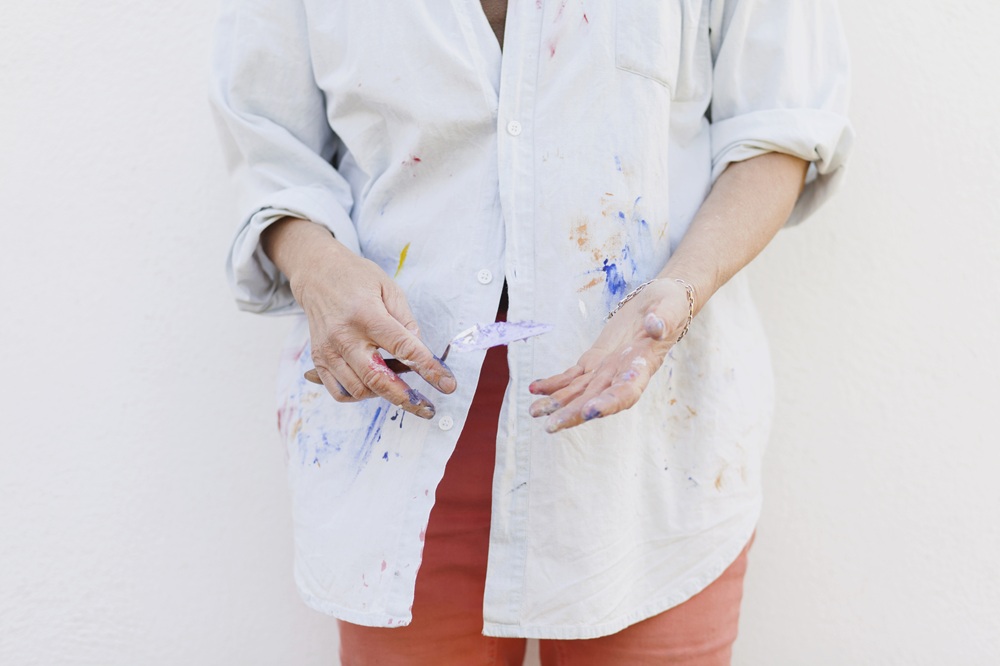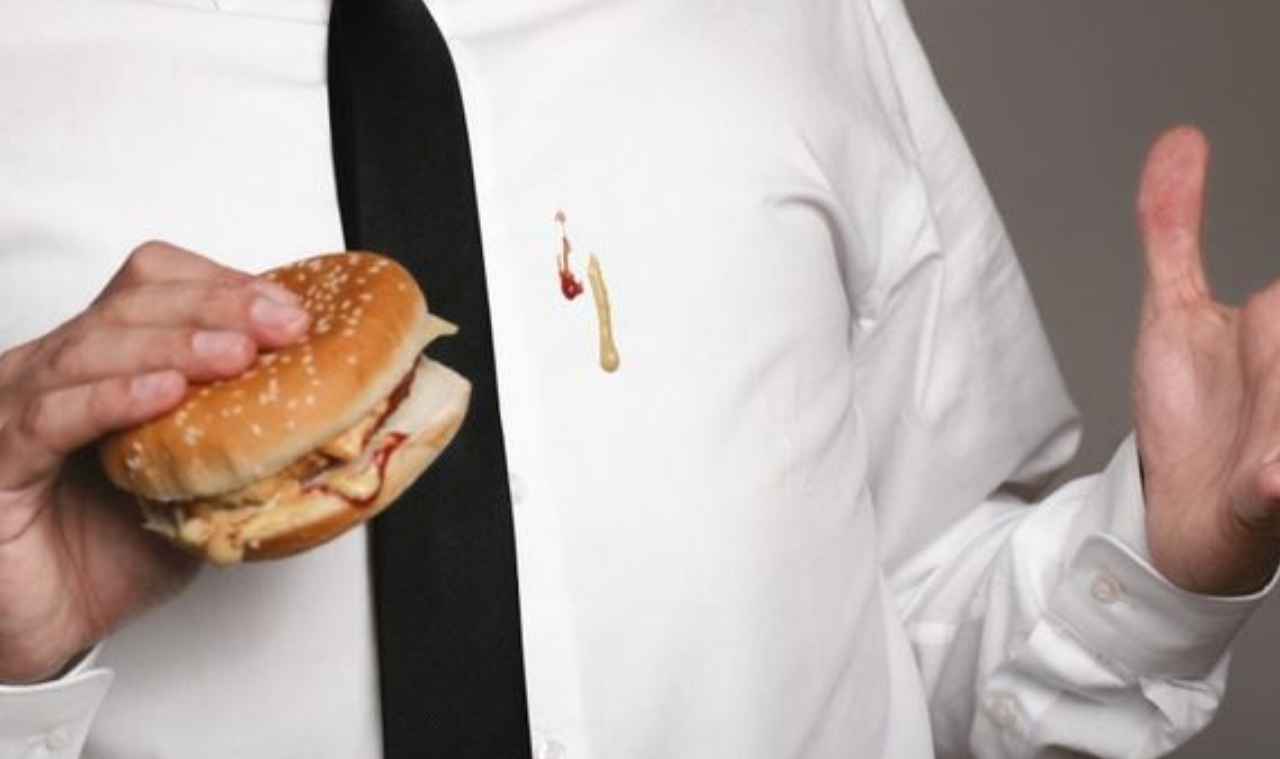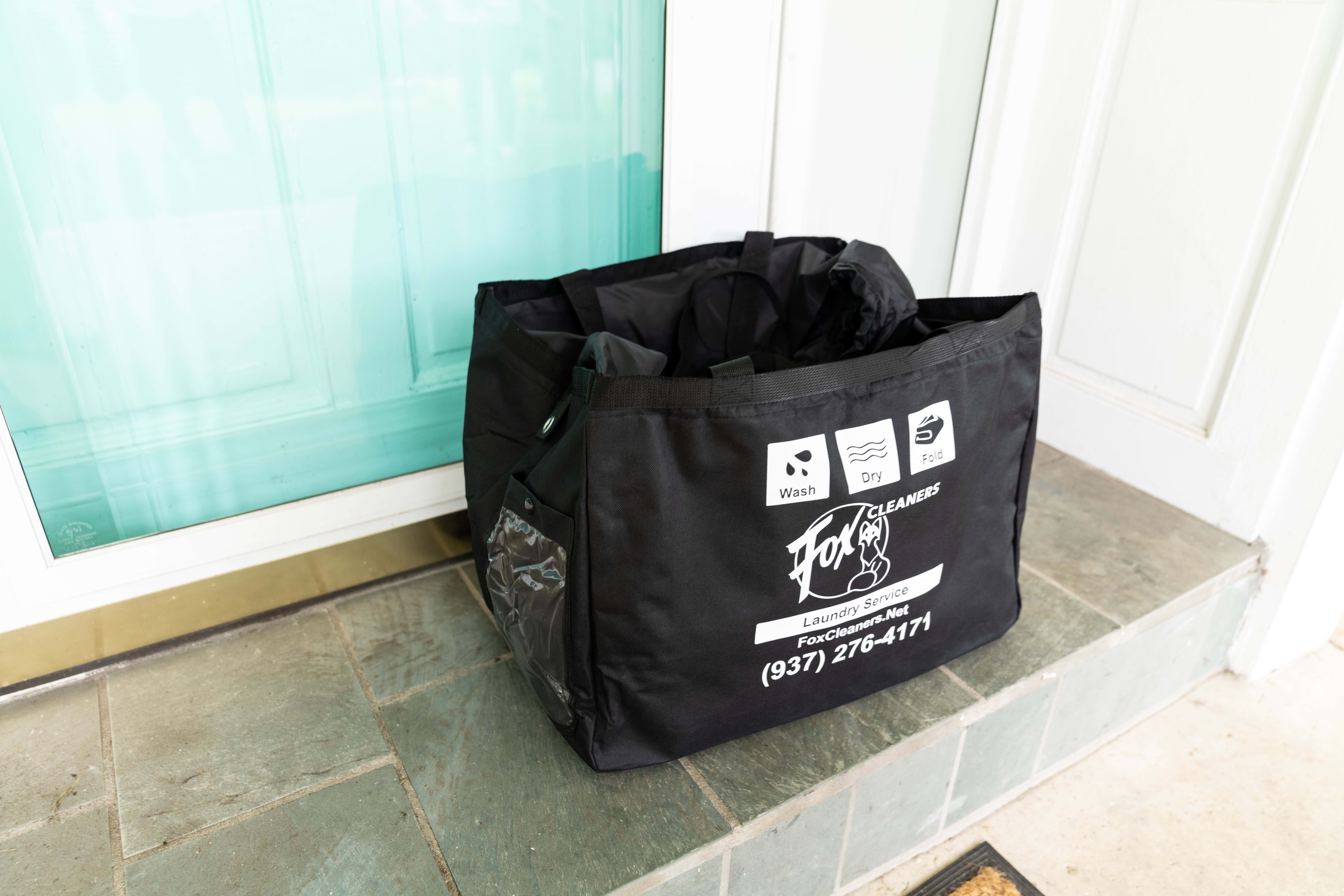Of course, not every stain needs expert treatment, but many do. It all depends on what caused it, how long it’s been there, and what kind of fabric it’s on. In this post, let’s go over the stains that are safest in a professional’s hands.
1) Oil and Grease Stains from Food, Lotion, or Car Fluids
Oil and grease are some of the most stubborn stains out there, and they’re also some of the easiest to ruin with DIY methods. Whether it’s salad dressing on your blouse, hand lotion on your pants, or a spot from car grease, these stains tend to soak into fabric fibers and spread quickly. Water-based detergents won’t cut through oil, which is why these stains often look worse after home treatment.
Why Oil-based Stains Are Better Suited for Dry Cleaning
- Oil doesn’t dissolve in water. It requires a solvent-based solution most home laundry setups don’t have.
- Home blotting often spreads the stain. When you press or rub oil, you likely push it deeper into the fibers.
- Delicate fabrics like silk or wool can be permanently discolored. Dry cleaners know how to treat stains without damaging the garment.
- Dry cleaners pretreat oil stains. Professionals apply targeted spotting agents before cleaning to break down the grease effectively.
If you notice an oily patch forming, don’t let it sit. The longer it’s there, the more it sets, so drop it off at your local dry cleaners as soon as you can.
2) Ink Stains from Pens, Markers, or Printer Cartridges
Ink can go from a small mark to a full-on disaster in seconds. Whether it leaks into your shirt pocket or smears on your bedding, ink is a pigment-based stain that binds tightly to fabric. Trying to treat it at home can easily cause the stain to spread or “bleed” outwards.
Why Ink Needs Professional Treatment
- Ink is highly pigmented. These stains require solvents that break down ink without affecting the original color of the fabric.
- The wrong method makes it worse. Rubbing alcohol, hairspray, and bleach may seem like a fix, but they often damage fabric or set the stain.
- Dry cleaners isolate the stain. They use controlled spotting techniques that keep it from spreading.
- They test before treating. Professionals perform fabric tests to ensure the solvent won’t cause fading or holes.
3) Lipstick, Foundation, and Makeup Residue on Fabric
Makeup is meant to stick — and it does, especially on clothing. Lipstick, foundation, bronzer, and mascara all contain oils, pigments, and waxes that cling tightly to textiles. Rubbing it with a tissue or using makeup wipes usually drives it deeper into the material.
Why Makeup Stains Need the Expertise of a Professional Dry Cleaner
- They understand fabric sensitivity. Silk, satin, and chiffon are especially vulnerable to DIY cleaning damage.
- They break down multi-layered stains. Lipstick and foundation are combo stains (oil + pigment + wax), so they need several spot treatments.
- Home scrubbing creates friction damage. Dry cleaners avoid wear and tear using gentle but effective blotting and solvent use.
- They know how to prevent rings. Amateurs often leave behind halos; pros know how to lift the stain evenly.
If your favorite dress ends up with foundation on the collar, don’t panic! Just take it to the closest dry cleaners before the stain sets.
4) Red Wine, Coffee, or Tea Spills on Clothing or Linens
Spilling your morning coffee or a glass of red wine might feel like a lost cause, especially on white clothing or bedding. These are tannin-based stains that darken over time and react poorly to heat, making your washing machine a risky solution.
Why Dry Cleaners Handle Tannin-based Stains Best
- They use tannin removers. These are chemical agents made to target plant-based compounds like tea, wine, and coffee.
- They avoid setting the stain. At-home drying or ironing can “cook” the stain into the fabric, making removal nearly impossible.
- They use cold treatments on stains. Heat activates and locks in these stains; dry cleaners know to work cool and fast.
- They treat linens without yellowing. Bedding and tablecloths need specialized cleaning to maintain brightness.
5) Blood, Sweat, and Other Protein-based Stains
Blood, sweat, dairy, and other body fluids fall under the category of protein stains. These require a careful, controlled approach, especially if they’ve dried. Hot water and bleach only make them harder to remove.
How Dry Cleaners Treat Protein Stains
- They use enzyme pretreatments. These break down protein molecules without damaging the fabric.
- They work fast before stains oxidize. Once protein dries and oxidizes, it becomes significantly harder to remove.
- They know when to use wet vs. dry methods. Not all protein stains need dry cleaning; some require a blend of both processes.
- They preserve delicate materials. Blood on lace, wool, or silk needs a specialized approach to prevent color loss or tearing.
If your wedding dress, shirt, or sheets have protein stains, it’s time to look up dry cleaners and hand them off to an expert.
6) Paint, Dye, and Hair Color Transfers on Fabrics

Paint, fabric dye, and even semi-permanent hair color can cause a mess that seems impossible to fix. Once they bind to fibers, water and soap won’t touch them, and scrubbing might actually set the color permanently.
What Dry Cleaners Do Differently
- They use solvent-based spot removers. These break the chemical bond between the stain and the fabric.
- They test for colorfastness. Professionals ensure the treatment won’t lift the original fabric dye along with the stain.
- They understand fabric safety. Delicate or synthetic materials need a precise chemical balance to prevent melting or fading.
- They act quickly. The faster you take it in, the higher the chance of complete stain removal.
If your jeans catch hair dye or your child’s uniform gets splattered with paint, take it straight to the pros for assessment.
Don’t Gamble with That Stain on Your Dress — Take It to the Dry Cleaning Experts at Fox Cleaners!
Sure, some stains can be dealt with at home, but when it comes to tough marks that could ruin your favorite dress, why take the risk? With Fox Cleaners’ Dry Cleaning Service, you get expert care that targets even the most stubborn stains, all while helping to extend the life of your fabrics. Our dry cleaning process is incredibly effective at removing a wide range of stains, so your clothes and home essentials look as good as new.
Dry cleaning is not only effective on most stains, but it’s also the safest option for your finer pieces. From silk dresses and wool suits to embellished or vintage garments, we carefully assess each item and use the right cleaning method to get results without causing damage. While not every stain is guaranteed to disappear completely, our experienced team puts in the extra effort to restore your items to their best condition.
At Fox Cleaners, we use hydrocarbon, an eco-friendly solution that cleans thoroughly without leaving behind moisture. Most garments are ready in three to five days, and we’re always up front about pricing and turnaround times.
Let our trained team handle what your detergent can’t. Call us at 937-883-6781 or visit our website at foxcleaners.com to find the Fox Cleaners location near you!




